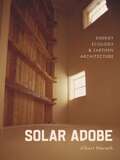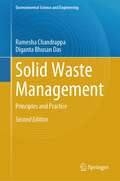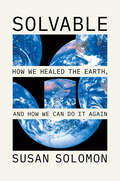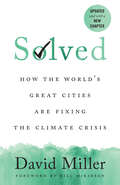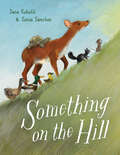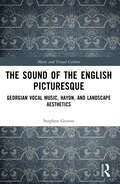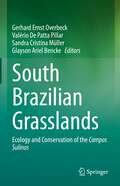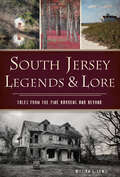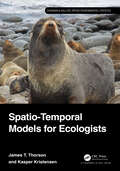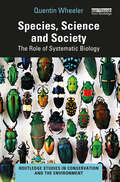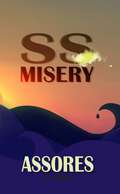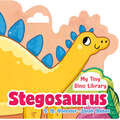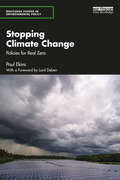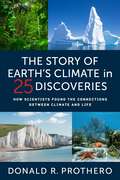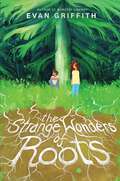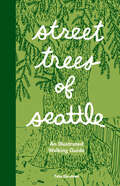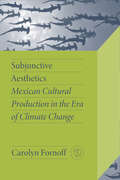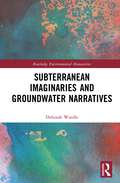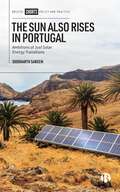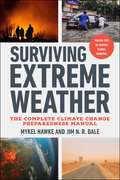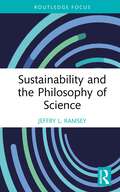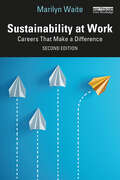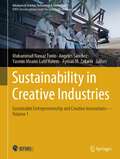- Table View
- List View
Solar Adobe: Energy, Ecology, and Earthen Architecture
by Albert NarathHow a centuries-old architectural tradition reemerged as a potential solution to the political and environmental crises of the 1970s Against the backdrop of a global energy crisis, a widespread movement embracing the use of raw earth materials for building construction emerged in the 1970s. Solar Adobe examines this new wave of architectural experimentation taking place in the United States, detailing how an ancient tradition became a point of convergence for issues of environmentalism, architecture, technology, and Indigenous resistance. Utilized for centuries by the Pueblo people of the American Southwest and by Spanish colonialists, adobe construction found renewed interest as various groups contended with the troubled legacies of modern architecture and an increasingly urgent need for sustainable design practices. In this period of critical experimentation, design networks that included architects, historians, counterculture communities, government weapons labs, and Indigenous activists all looked to adobe as a means to address pressing environmental and political issues. Albert Narath charts the unique capacities of adobe construction across a wide range of contexts, consistently troubling simple distinctions between traditional and modern technologies, high design and vernacular architecture. Drawing insightful parallels between architecture, environmentalism, and movements for Indigenous sovereignty, Solar Adobe stresses the importance of considering the history of the built environment in conjunction with architecture&’s larger impact on the natural world.
Solid Waste Management: Principles and Practice (Environmental Science and Engineering)
by Ramesha Chandrappa Diganta Bhusan DasThis book discusses solid waste management issues from global to local level. It offers an overview of the methods and paradigms of this burgeoning field, ranging from generation, characteristics, quantity, and practical challenges. The book discusses the major issues with respect to environmental health and economy, which are related to solid waste management. Furthermore, it contains updated information on topics such as toxicology, climate change, population pressure, urbanization, energy production, building and community design, and disaster preparedness in the context of solid waste management.
Solvable: How We Healed the Earth, and How We Can Do It Again
by Susan SolomonA compelling and pragmatic argument: solutions to yesterday’s environmental problems reveal today’s path forward. We solved planet-threatening problems before, Susan Solomon argues, and we can do it again. Solomon knows firsthand what those solutions entail. She first gained international fame as the leader of an expedition to Antarctica in 1986, making discoveries that were key to healing the damaged ozone layer. She saw a path—from scientific and public awareness to political engagement, international agreement, industry involvement, and effective action. Solomon, an atmospheric scientist and award-winning author, connects this career-defining triumph to the inside stories of other past environmental victories—against ozone depletion, smog, pesticides, and lead—to extract the essential elements of what makes change possible. The path to success begins when an environmental problem becomes both personal and perceptible to the general public. Lawmakers, diplomats, industries, and international agencies respond to popular momentum, and effective change takes place in tandem with consumer pressure when legislation and regulation yield practical solutions. Healing the planet is a long game won not by fear and panic but by the union of public, political, and regulatory pressure. Solvable is a book for anyone who has ever despaired about the climate crisis. As Solomon reminds us, doom and gloom get us nowhere, and idealism will only take us so far. The heroes in these stories range from angry mothers to gang members turned social activists, to upset Long Island birdwatchers to iconoclastic scientists (often women) to brilliant legislative craftsmen. Solomon’s authoritative point of view is an inspiration, a reality check, a road map, and a much-needed dose of realism. The problems facing our planet are Solvable. Solomon shows us how.
Solved: How the World’s Great Cities Are Fixing the Climate Crisis
by David MillerIf our planet is going to survive the climate crisis, we need to act rapidly. Taking cues from progressive cities around the world, including Los Angeles, New York, Toronto, Oslo, Shenzhen, and Sydney, this book is a summons to every city to make small but significant changes that can drastically reduce our carbon footprint. We cannot wait for national governments to agree on how to reduce greenhouse gas emissions and manage the average temperature rise to within 1.5 degrees. In Solved, David Miller argues that cities are taking action on climate change because they can – and because they must. The updated paperback edition of Solved: How the World’s Great Cities Are Fixing the Climate Crisis demonstrates that the initiatives cities have taken to control the climate crisis can make a real difference in reducing global emissions if implemented worldwide. By chronicling the stories of how cities have taken action to meet and exceed emissions targets laid out in the Paris Agreement, Miller empowers readers to fix the climate crisis. As much a “how to” guide for policymakers as a work for concerned citizens, Solved aims to inspire hope through its clear and factual analysis of what can be done – now, today – to mitigate our harmful emissions and pave the way to a 1.5-degree world.
Something on the Hill
by Jane KohuthCelebrate the arrival of Spring with this picture book that follows a small field mouse as she rallies the larger woodland animals to join her on a journey up a hill, sensing that something is about to happen at the top.... What could it be?!When Field Mouse wakes from her nap, the air is no longer chilly, and she feels like there's something has changed. Something is out there, calling to her.... Something is on the Hill. She spots her friend, Squirrel. "Help me find the Something," Mouse tells him. And so the two scamper through a clearing. Soon, they spot Doe. "Where are you hurrying today?" Doe asks them. "We're going to the Hill," says Mouse. And so it goes, as Turtle, the Ducks, and the Bears join the group, all making their way to the Something on the Hill. As they climb to the tippy-top, this parade of animals will discover just what that Something is: a leaf shoot, tiny and green. Just in time for spring comes this delightful picture book--perfect for storytime--that reminds us that the smallest of things can matter just as much as the big ones.
The Sound of the English Picturesque: Georgian Vocal Music, Haydn, and Landscape Aesthetics (Music and Visual Culture)
by Stephen GrovesRevealing the connections between the veneration of national landscape and eighteenth- century English vocal music, this study restores English music’s relationship with the picturesque. In the eighteenth century, the emerging taste for the picturesque was central to British aesthetics, as poets and painters gained popularity by glorifying the local landscape in works concurrent with the emergence of native countryside tourism. Yet English music was seldom discussed as a medium for conveying national scenic beauty. Stephen Groves explores this gap, and shows how secular song, the glee, and national theatre music expressed a uniquely English engagement with landscape. Using an interdisciplinary approach, Groves addresses the apparent ‘silence’ of the English picturesque. The book draws on analysis of the visualisations present in the texts of English vocal music, and their musical treatment, to demonstrate how local composers incorporated celebrations of landscape into their works. The final chapter shows that the English picturesque was a crucial influence on Joseph Haydn’s oratorio The Seasons. Suitable for anyone with an interest in eighteenth- century music, aesthetics, and the natural environment, this book will appeal to a wide range of specialists and non- specialists alike.
South Brazilian Grasslands: Ecology and Conservation of the Campos Sulinos
by Gerhard Ernst Overbeck Valério De Patta Pillar Sandra Cristina Müller Glayson Ariel BenckeThis volume explores the South Brazilian grasslands, a unique complex of ecosystems in Brazil. Despite high biodiversity and many important ecosystem services, their biodiversity and conservation are neglected, both nationally, and globally. This book provides a state-of-the-art synthesis of knowledge on the biodiversity and its drivers in South Brazilian grasslands and associated ecosystems. Further, the book discusses conservation challenges and options, as well as management strategies that help to maintain the region’s uniqueness. The chapters present information on biodiversity and ecological features of the region, and put this information into the context of historical and current human land uses, allowing for links to global discussions of conservation and sustainable development. Altogether, the book contains 20 chapters organized in four sections. The book is directed at researchers, students and professionals working with biodiversity and sustainable development in southern Brazil, as well as to the international scientific and conservation community interested in grasslands and associated ecosystems, particularly in tropical and subtropical regions.
South Jersey Legends & Lore: Tales from the Pine Barrens and Beyond (American Legends)
by William J. LewisFrom Piney Folklore to Legendary Figures of South Jersey's Past Author William Lewis presents fascinating tales, revealing legends and beloved lore from the heart of Southern New Jersey.
Spatio-Temporal Models for Ecologists (Chapman & Hall/CRC Applied Environmental Statistics)
by James Thorson Kasper KristensenEcological dynamics are tremendously complicated and are studied at a variety of spatial and temporal scales. Ecologists often simplify analysis by describing changes in density of individuals across a landscape, and statistical methods are advancing rapidly for studying spatio-temporal dynamics. However, spatio-temporal statistics is often presented using a set of principles that may seem very distant from ecological theory or practice. This book seeks to introduce a minimal set of principles and numerical techniques for spatio-temporal statistics that can be used to implement a wide range of real-world ecological analyses regarding animal movement, population dynamics, community composition, causal attribution, and spatial dynamics. We provide a step-by-step illustration of techniques that combine core spatial-analysis packages in R with low-level computation using Template Model Builder. Techniques are showcased using real-world data from varied ecological systems, providing a toolset for hierarchical modelling of spatio-temporal processes. Spatio-Temporal Models for Ecologists is meant for graduate level students, alongside applied and academic ecologists.Key Features: Foundational ecological principles and analyses Thoughtful and thorough ecological examples Analyses conducted using a minimal toolbox and fast computation Code using R and TMB included in the book and available online
Species, Science and Society: The Role of Systematic Biology (Routledge Studies in Conservation and the Environment)
by Quentin Wheeler- presents an engaging and accessible examination of the role of systematic biology in species exploration and biodiversity conservation - clarifies misconceptions about systematic biology, reimagining it for the 21st Century - proposes an ambitious, planetary-scale project to inventory and make known every kind of plant, animal, and microbe on Earth - challenges the next and present generations of taxonomists to allow molecular data to assume it’s proper place alongside traditional data, to reembrace the fundamentally important mission of systematics - will be of great interest to those researching and working in systematics in botany and zoology, as well as professionals working in taxonomy and biodiversity conservation.
SS Misery
by AssoresUn libro sobre la supervivencia de la mente humana. Dos hombres perdidos en el mar tienen que enfrentar la lucha de estar solos y a la deriva. Al principio se llevan bien, pero apenas aparece un regalo misterioso, las cosas empiezan a ir cuesta abajo. Una novela que describe las condiciones en las que todos somos susceptibles. Un libro que muestra los límites de los humanos cuando enfrentamos la extinción personal. Cuando Severo y Maximiliano se encuentran perdidos en alta mar, ambos necesitan unir fuerzas para recuperar sus vidas. En medio de las dificultades, los dos necesitarán entenderse uno al otro para garantizar su supervivencia y, quién sabe, su cordura. SS Misery es una historia sobre perdición y humanidad.
Stegosaurus (My Tiny Dino Library)
by J. D. ForesterYoung readers will love exploring this dinosaur-shaped board book filled with playful rhymes and facts all about the mighty Stegosaurus!Stomp, stomp, stomp! Roar, roar, roar! Learn all about Stegosaurus, a Jurassic dinosaur!
Stopping Climate Change: Policies for Real Zero (Routledge Studies in Environmental Policy)
by Paul EkinsWritten by one of the leading experts in the field, Paul Ekins, Stopping Climate Change provides a comprehensive overview of what is required to achieve ‘real zero’ carbon dioxide emissions by 2050, and negative emissions thereafter, which is the only way to stop human- induced climate change. This will require innovation in socio-technical systems, and in human behaviour, on an unprecedented scale. Stopping Climate Change describes the changes required to meet this goal: in technologies, social institutions and individual activities. Paul Ekins examines in detail issues around the supply and demand of energy and materials, and the efficiency of their use. It also analyses greenhouse gas removal technologies, offsetting and geoengineering, and plots the reduction of the non- CO2 greenhouse gas-emitting activities. Having set out the changes required, Ekins considers the economic implications, in terms of both the innovation and investments that are necessary to bring them about, and the effects that these are likely to have on national economies. The evidence presented points clearly to the economic impacts of decarbonisation being positive for the majority of countries, and for the world as a whole, even before considering the benefits of avoided climate change. When the health benefits of stopping the burning of fossil fuels are factored in, the global net benefits of decarbonisation are unequivocal. Drawing on examples from the UK and Europe, but with wider relevance at a global scale, Stopping Climate Change clearly shows how determined policy action at different levels could stop climate change. It will be of great interest to students, scholars and policymakers researching and working in the field of climate change and energy policy.
Stopping Climate Change: Policies for Real Zero (Routledge Studies in Environmental Policy)
by Paul EkinsWritten by one of the leading experts in the field, Paul Ekins, Stopping Climate Change provides a comprehensive overview of what is required to achieve ‘real zero’ carbon dioxide emissions by 2050, and negative emissions thereafter, which is the only way to stop human- induced climate change.This will require innovation in socio-technical systems, and in human behaviour, on an unprecedented scale. Stopping Climate Change describes the changes required to meet this goal: in technologies, social institutions and individual activities. Paul Ekins examines in detail issues around the supply and demand of energy and materials, and the efficiency of their use. It also analyses greenhouse gas removal technologies, offsetting and geoengineering, and plots the reduction of the non- CO2 greenhouse gas-emitting activities. Having set out the changes required, Ekins considers the economic implications, in terms of both the innovation and investments that are necessary to bring them about, and the effects that these are likely to have on national economies. The evidence presented points clearly to the economic impacts of decarbonisation being positive for the majority of countries, and for the world as a whole, even before considering the benefits of avoided climate change. When the health benefits of stopping the burning of fossil fuels are factored in, the global net benefits of decarbonisation are unequivocal.Drawing on examples from the UK and Europe, but with wider relevance at a global scale, Stopping Climate Change clearly shows how determined policy action at different levels could stop climate change. It will be of great interest to students, scholars and policymakers researching and working in the field of climate change and energy policy.
The Story of Earth's Climate in 25 Discoveries: How Scientists Found the Connections Between Climate and Life
by Donald R. ProtheroOver 4.5 billion years, Earth’s climate has transformed tremendously. Before our more temperate recent past, the planet swung from one extreme to another—from a greenhouse world of sweltering temperatures and high sea levels to a “snowball earth” in which glaciers reached the equator. During this history, we now know, living things and the climate have always influenced and even shaped each other. But the climate has never changed as rapidly or as drastically as it has since the Industrial Revolution.In this lively and entertaining book, Donald R. Prothero explores the astonishing connections between climate and life through the ages, telling the remarkable stories of the scientists who made crucial discoveries. Journeying through the intertwined evolution of climate and life, he tackles questions such as: Why do we have phytoplankton to thank for the air we breathe? What kind of climate was necessary for the rise of the dinosaurs—or the mammals, their successors? When and how have climatic changes caused mass extinctions? Prothero concludes with the Ice Ages and the Holocene, the role of climate in human history, and the perils of anthropogenic climate change. Understanding why the climate has changed in the past, this timely book shows, is essential to grasping the gravity of how radically human activity is altering the climate today.
The Strange Wonders of Roots
by Evan GriffithFrom the acclaimed author of Manatee Summer comes a poignant story about a girl who learns to lay down roots as she’s drawn into a fight over a local grove of trees that’s in danger of being torn down. Perfect for fans of Hoot and Operation Redwood.Holly Foster knows that nothing lasts—not hometowns or schools, or even family. It’s just safer to keep herself uninvolved. So when she’s sent to spend part of the summer with her uncle, she knows better than to get attached to him…or any part of his small Vermont town of Arden.But when she arrives, she’s drawn into the drama that’s split the town: The local plastic factory is trying to tear down the trees in the center of Arden to build a visitor’s center and museum. Holly shocks herself by stepping into the fray and taking on one of the most powerful families in the area. But as she learns more about the town—and makes a new friend or two—Holly is determined to protect the one place she thinks she could finally belong. But will she be able to convince the other townspeople that the trees deserve to stay?
Street Trees of Seattle: An Illustrated Walking Guide
by Taha EbrahimiThe majestic trees of Seattle's neighborhoods take center stage in this illustrated and informative walking guide. Want to discover which neighborhood has the highest concentration of cherry street trees when cherry blossoms are at their peak?Eager to stroll down the only street lined with western red cedars?Curious how monkey puzzle trees made their way to the city?Using data visualization as a starting point, the author takes readers on a tour of existing street trees throughout Seattle's neighborhoods and iconic parks through charming illustrations and maps. In the process, she educates readers on the history of the trees and the city, and offers up sketches of trees, leaves, and leaflets to identify trees throughout 33 different neighborhoods. The most notable of each species are highlighted, so urban adventurers can fully appreciate their surroundings or design their own walking routes to experience these natural wonders in their favorite areas of the city.The book is organized alphabetically by neighborhood and each area: Showcases a species of treeIncludes a history of the tree and neighborhoodOffers maps and callouts for spotting the best street specimens In an increasingly digital world, the book invites readers to slow down and embrace an analog approach to tree-spotting during their urban meanderings.
Subjunctive Aesthetics: Mexican Cultural Production in the Era of Climate Change (Critical Mexican Studies)
by Carolyn FornoffDuring the twenty-first century, Mexico has escalated extractive concessions at the same time that it has positioned itself as an international leader in the fight against climate change. Cultural production emergent from this contradiction frames this impasse as a crisis of imagination. Subjunctive Aesthetics studies how contemporary writers, filmmakers, and visual artists grapple with the threat that climate change and extractivist policies pose to Mexico's present and future. It explores how artists rise to the challenge of envisioning alternative forms of territoriality (ways of being in relation to the environment) through strategies ranging from rewriting to counterfactual speculation. Whereas ecocritical studies have often focused on art's evidentiary role—its ability to visualize and prove the urgency of environmental damage—author Carolyn Fornoff argues that what unites the artists under consideration is their use of more hypothetical, uncertain representational modes, or "subjunctive aesthetics." In English, the subjunctive is a grammatical mode that articulates the imagined, desired, and possible. In the Spanish language, it is even more widely used to express doubts, denials, value judgments, and emotions. Each chapter of Subjunctive Aesthetics takes up one of these modalities to examine how Mexican artists, writers, and filmmakers activate approaches to the planet not just as it is, but as it could be or should be.
Subterranean Imaginaries and Groundwater Narratives (Routledge Environmental Humanities)
by Deborah WardleThis book interrogates the problems of how and why largely unseen matter, in this case groundwater, has found limited expression in climate fiction. It explores key considerations for writing groundwater narratives in the Anthropocene. The book investigates a unique selection of climate fiction alongside an exploration of hydrosocial environmental humanities through a focus on groundwater and groundwater narratives. Providing eco-critical analysis, with creative fiction and non-fiction excerpts interwoven throughout, and drawing on Indigenous Australian and Australian settler novels and poems alongside European, American and Japanese texts, the book illuminates the processes of ‘storying with’ subterranean waters – their facts, uncertainties, potencies and vulnerabilities. In a time when the water crisis in an Australian and worldwide context is escalating in response to global warming, giving voice to the complexities of groundwater extraction and pollution is vital. Drawing from non-representational, posthumanist and feminist perspectives, the book provides an important contribution to transnational, comparative climate fiction analysis, enabling an interdisciplinary exchange between hydrogeological science and the eco-humanities. This book is an engaging read for scholars and students in creative writing, environmental humanities, cultural and post-colonial studies, Australian studies, and eco-critical literary studies. Writers and thinkers addressing the problems of the Anthropocene are called to pay attention to the importance of subterranean imaginaries and groundwater narratives.
Summer's Magic (An Indigenous Celebration of Nature)
by Kaitlin B. CurticeAn Indigenous boy invites new friends to share in beloved traditions as he celebrates the joy of summer and his love for Earth and Creator in this picture book that revels in the warmth, light, and fun of the longest days of the year.Bo, a proud Potawatomi boy, is excited to enjoy long summer days tending his garden, walking his dog, and playing in the river with his big sister, Dani. When he discovers that his family's favorite spot has been polluted with garbage, Bo realizes that caring for Earth is part of what makes summer special. And when he overcomes his shyness and invites others to join in, he discovers that summer's magic has even more surprises in store.&“Bo is short for saying Bodewadmi ndaw, which is &‘I am Potawatomi&’ in our language. Bo is a celebration of Anishinaabe culture, from the way he wears his hair in a traditional braid to the way he shares the magic of summer and honors Earth by caring for her as she cares for us.&”—Kaitlin B. Curtice
The Sun Also Rises in Portugal: Ambitions of Just Solar Energy Transitions
by Siddharth SareenAvailable open access digitally under CC-BY-NC-ND licence. Portugal is among the best-placed European countries to take advantage of solar power, having achieved a five-fold increase in installed capacity during 2017-2023 despite financial constraints. In 2023, its National Energy and Climate Plan set an ambitious target for a further eight-fold increase from 2.5 GW to 20.4 GW by 2030. How can such fast-paced deployment secure sociospatial justice? What insights do political economic dynamics hold for future transitions? Drawing on long-term, multi-sited ethnographic fieldwork, this book is a one-stop resource for policy makers, practitioners, scholars, and anyone interested in just solar energy transitions. Siddharth Sareen won the 2024 Nils Klim Prize, recognising his exemplary work in the search for renewable and sustainable sources of energy.
Surviving Extreme Weather: The Complete Climate Change Preparedness Manual
by Mykel Hawke Jim N.R. DaleThe only guide you need to prepare for the dangerous effects of climate change. The world has changed, and impacts of global warming means weather events like extreme heat, wildfires, hurricanes, and droughts are now being felt by all of us. We can ignore climate change no longer and must prepare ourselves to survive in new conditions. The key to surviving extreme weather events is to understand them from a practical perspective and then plan and execute tactical responses. In Surviving Extreme Weather, Mykel Hawke, a renowned survivalist and bestselling author of Hawke&’s Special Forces Survival Handbook and Hawke&’s Green Beret Survival Manual, and British meteorologist Jim N. R. Dale, share their expert knowledge and personal experiences while offering valuable insights into the science behind our new weather and how to apply situational awareness, preparedness, and psychology to survive.Surviving Extreme Weather: The Complete Climate Change Preparedness Manual is categorized by elements—fire, water, wind, and earth—events are explained with recommendations anyone can follow to protect themselves and their family, and to minimize the risks of damage to life and property. Included are lists of items every person, home, business, and vehicle should always stock, such as: first aid kits, afflictions, and applications; emerging technologies to help protect against different weather phenomena; structural and landscape precautions and improvements; philosophies to help family, friends, and neighbors get through any environmental ordeal.
Sustainability and the Philosophy of Science (Routledge Focus on Environment and Sustainability)
by Jeffry L. RamseyThis book demonstrates how the philosophy of science can enhance our understanding of sustainability and the practices we use to enact it. Examining assumptions about concepts, theories, evidence, and the moral ideals of sustainability can better orient us as we pursue this urgent and important goal. The book applies perspectives and tools from the philosophy of science – construed broadly to include portions of science and technology studies, history of science, and philosophy more generally – to sustainability discourse. It argues that widely held assumptions regarding the meaning of concepts, methods of theorizing and inferential practice, evidential structure, and ethics limit our understanding and practice of sustainability. It offers philosophical alternatives that capture more fully the confusing, wicked nature of sustainability challenges. The alternatives draw attention to existing but often undervalued frameworks in sustainability discourse. This book is aimed towards academics, researchers, and post-graduates working in sustainability, as well as philosophers of science and environmental philosophers interested in the philosophical issues raised by the pursuit of sustainability.
Sustainability at Work: Careers That Make a Difference
by Marilyn WaiteSustainability at Work is a compelling guide for anyone who seeks both a successful career and a career that makes a positive difference in society.Containing career advice of great value to students and professionals, and explaining how one can integrate sustainability into future roles, this book’s appeal extends far beyond those well versed in sustainability thinking. The text includes an easy-to-follow structure—the SURF Framework—that anyone wondering how they can make a difference in the workplace can apply. In this thoroughly revised new edition, Marilyn Waite builds upon recent career trends to include two all-important themes that are redefining sustainability: justice, equity, diversity, and inclusion and climate-related career pathways. In addition, practical advice for finding and creating roles that correspond to one’s preferences and purpose is elaborated. The book explains how real people in a plethora of sectors can have a positive impact on people and planet. Professionals from a variety of backgrounds and locations explain how they brought a sustainability approach to various sectors, including agriculture, business, economics, and financial services, education and research, entertainment and media, health care, law and policy, and science and technology. The breadth of stories covers individuals working on five continents in various levels of responsibility.Through inspiring narratives and a structured framework, Sustainability at Work illustrates how sustainability can be incorporated into every imaginable career to impact the quadruple bottom line: environment, economy, society, and future generations.
Sustainability in Creative Industries: Sustainable Entrepreneurship and Creative Innovations—Volume 1 (Advances in Science, Technology & Innovation)
by Muhammad Nawaz Tunio Angeles Sánchez Yasmin Moanis Latif Hatem Ayman M. ZakariaThis book discusses a compelling array of topics at the intersection of entrepreneurship, education, and technological innovation within the creative industries. It delves into a captivating exploration of sustainable entrepreneurship in Part 1, where key characteristics of sustainable entrepreneurs and factors influencing entrepreneurial intention are dissected. By unearthing the nexus between entrepreneurial alertness, networking capability, and venture performance, it provides intriguing insights into sustaining traditional crafts and brands amid the COVID-19 pandemic. The following parts not only unveil current innovative pedagogical strategies in creative design education but propels you into the future, exploring the harmonious fusion of academia and industry in sustainability-driven programs. Designed for educators, students, researchers, and practitioners in entrepreneurship, design, and technology fields, this book offers a transformative journey into sustainable practices, innovative pedagogies, and cutting-edge advancements. Engaging, informative, and thought-provoking, it is a must-read for those seeking to shape the future of creative industries through entrepreneurship, education, and innovation.
